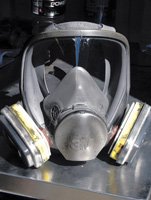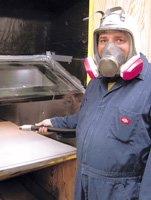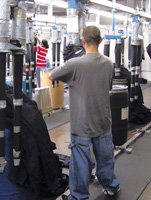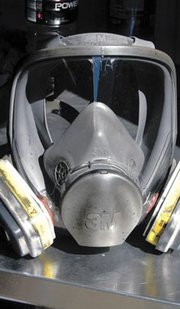Levi's Sandblast Ban Doesn't Make Waves in L.A. Production
Inside the behemoth American Dye House, a 60,000-foot facility in an industrial section of Los Angeles, dozens of workers are busy adding special treatments to some of the city’s most famous blue-jeans labels, including True Religion, Rock & Republic and Hudson.
Employees in one room, filled with a host of inflatable rubber legs covered with denim pants, use sandpaper across the backs of blue jeans to give them a slightly aged look.
Downstairs in another room, a worker dons an elaborate face mask to complete his protective suit—full-length zip-up overalls and gloves—before working at a sandblasting machine that hurls fine particles of sand brought in from a Caribbean island at blue jeans.
For decades, dye and washhouses in Los Angeles have been using sandblasting techniques on blue jeans to give them a certain distressed look you cannot get with other methods.
But now that technique is coming under scrutiny after Levi Strauss & Co. and Swedish retailer H&M announced on Sept. 7 they would no longer use sandblasting in their collections because they couldn’t count on overseas factories to use proper equipment to protect workers’ health.
David Love, chief supply-chain officer at Levi’s, said in a blog that sandblasting is a great technique for giving each pair of blue jeans its own unique look. But when sandblasting is used, rigorous work practices must be in place to protect factory workers from potentially serious harm resulting from exposure to silica, a compound found in sand.
“We recognize that there are factories, often linked to counterfeit operations that do not apply these same safeguards” Love wrote.
Levi’s didn’t mention where these factories are located, but most of the company’s production is done in China, where safety regulations are not as stringent as in the United States.
In Turkey, there were 42 known cases of silicosis, a lung disease caused by prolonged inhalation of silica, among denim sandblasters in 2007, up from seven cases in 2004. Ataturk University, whose medical clinics and researchers were seeing more cases of silicosis, found that two teenagers working in the garment industry died of the disease. The teens had been working in the hundreds of unregistered workplaces in Istanbul and in the eastern part of Turkey. Suiting up
In California, the state Department of Occupational Safety and Health has guidelines that stipulate what kind of protective gear must be used and what measures must be in place when using any sandblasting equipment, said Krisann Chasarik a Cal/OSHA spokeswoman.
And Los Angeles factories are making sure they adhere to those guidelines.
At American Dye House, which is building two more sandblasting stations to add to its existing four, all workers must be fully suited before they wield a sandblasting hose.
Even though denim sandblasting is down from its height about six or seven years ago, factories and washhouses still employ it for certain looks. But most premium lines prefer to use hand sanding to achieve a more refined finish. Still, sandblasting it not a method that is going to drop by the wayside soon.
Sandblasting is widely used at Koos Manufacturing, the largest blue jeans factory in Los Angeles, where six stations are set up. Sam Ku, vice president and design director, said the company requires all its employees to wear protective gear and face masks when working with sandblasting equipment. “It almost looks like a space suit,” Ku said, describing his workers’ sandblasting garb.
In addition, Koos has oxygen hooked up to workers’ masks so they have a fresh supply of air. “The dust from crystalline silica is the most harmful for those breathing it,” Ku noted. “The combination of crystalline silica and no mask is a recipe for disaster.”
A little less than half of Koos’ production of 25,000 blue jeans a week, many bearing the company’s AG Adriano Goldschmied label, have some kind of sandblasting technique added to achieve a vintage look. To round out the finish, the company also employs lasers and hand-sanding.
Jerome Dahan, co-founder of the Citizens of Humanity blue-jeans label in Los Angeles, said denim sandblasting is definitely waning. But he still employs it at his CM Laundry, where the technique is used for subtle whiskers. Workers at the laundry’s eight sandblasting stations are fully suited up when they start blasting away. “You have to protect your workers,” Dahan said.
While strict measures are in place in the United States, denim makers have a harder time monitoring sandblasting in overseas factories. Christopher Enuke, creative director at It! Jeans, a Los Angeles denim label for juniors, said he just returned from China, where three of his 11 menswear styles for Spring 2011 will be using sandblasting for three-dimensional whiskers. “Sandblasting is messy,” the designer said. “Hand-sanding is more expensive, and sandblasting cuts down on the expense of hand-sanding.”
He said the Chinese factories he uses must follow guidelines set up by It! Jeans to remain partners. “China is pretty much jungle warfare,” he noted. “Unless you say what you want, they are going to do whatever they want. We have a rule book.”

























